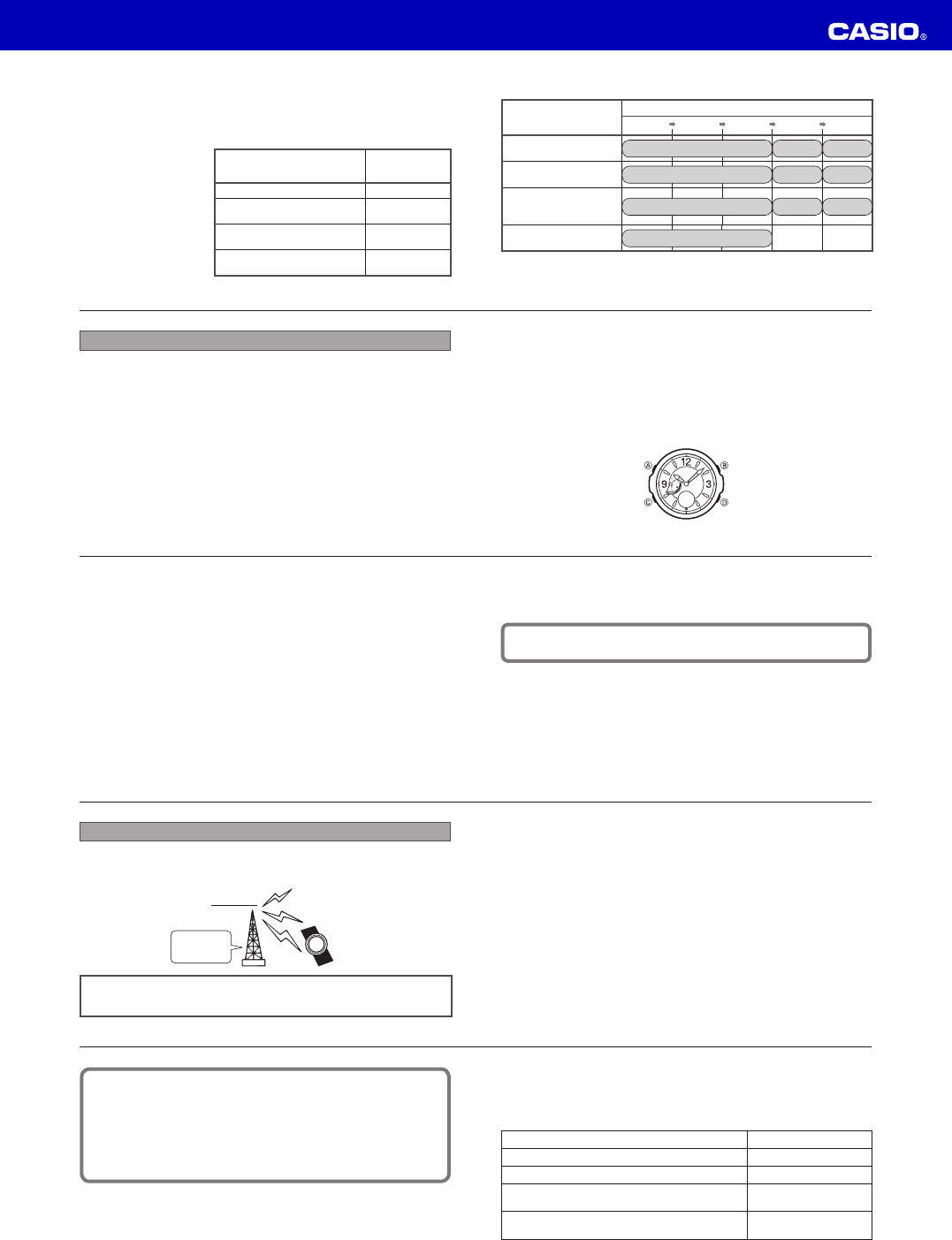
Operation Guide 5145
39
Reception Ranges ■
The table below shows the time calibration signal that the watch receives when a
particular city code is selected as your Home City.
For information about the Home City setting, see page 67. See page 73 for details x
about city codes.
Home City (Cities that support signal reception) Radio receiver
TPE, SEL, TYO Japan (JJY)
HKG, BJS China (BPC)
(HNL), (ANC), YVR, LAX, YEA, DEN, MEX, CHI, NYC,
YHZ, YYT
United States (WWVB)
LIS, LON, MAD, PAR, ROM, BER, STO, ATH, (MOW)
U.K. (MSF) and Germany
(DCF77)
City codes in parentheses indicate areas where reception may be possible only x
when conditions are good.
38
Note that transmission of the Japanese calibration signal may be interrupted
occasionally due to maintenance, lightning, etc.
For more information, visit the website of the Japan Standard Time Group of
the National Institute of Information and Communications Technology (NICT) at
the URL below.
http://jjy.nict.go.jp/
Note that the above URL is subject to change.x
37
Calibration Signal ■
The Japanese calibration signal (Call Sign: JJY) is maintained by the National ●
Institute of Information and Communications Technology (NICT). It is transmitted
24 hours a day from Mt. Otakadoya (40 kHz) located in Fukushima Prefecture, and
from Mt. Hagane (60 kHz) located on the border between Saga Prefecture and
Fukuoka Prefecture.
The Chinese calibration signal (Call Sign: BPC) is maintained by National Time ●
Service center (NTSC) of China and is transmitted from Shangqiu.
The U.S. calibration signal (Call Sign: WWVB) is transmitted by the National ●
Institute of Standards and Technology (NIST) from Fort Collins, Colorado.
The U.K. calibration signal (Call Sign: MSF) is transmitted by the National Physical ●
Laboratory (NPL) from Anthorn, which is located near Anthorn, Cumbria.
The German calibration signal (Call Sign: DCF77) is transmitted by Physikalisch - ●
Technische Bundesanstalt (PTB) in Mainfl ingen, which is located southeast of
Frankfurt.
Time calibration signal frequencies and transmitter locations are subject to change.x
36
How a Radio-controlled Watch Works
What is a radio-controlled watch? ■
A radio-controlled watch is designed to receive a time calibration signal that contains
standard time data, and adjust its current time setting accordingly.
7UDQVPLWWHU
:DWFK
&HVLXP
DWRPLFFORFN
/RQJZDYHWLPH
FDOLEUDWLRQVLJQDO
After the watch receives a Standard Time signal, it performs internal calculations
to determine the current time. Because of this, there may be an error of up to
one second in the indicated time.
35
Turning Power Saving On or Off ●
See the procedure under “Confi guring Time and Date Settings” (page 97) for
information about turning off Power Saving.
Leaving the watch in a drawer or anywhere else it is dark can cause Power
Saving to trigger in order to conserve battery power.
34
Function sleepx
Function sleep is triggered whenever the watch is left in the dark for six or seven
days.
Alarms and the hourly time signal are disabled. Analog timekeeping and auto x
signal receive are both disabled.
Internal timekeeping continues to operate normally.x
To recover from a sleep state ●
Move the watch to a brightly lit location or press any button.
It can take up to two seconds before display fi gures re-appear after you place the x
watch in a well-lit area.
33
What happens when the watch is in a sleep state ●
Display sleepx
Display sleep is triggered whenever the watch is left in the dark for about one hour
any time between the hours of 10 p.m. and 6 a.m.
The display goes blank in the display sleep state.x
Alarms and the hourly time signal continue to operate normally.
Digital-analog time coordination and auto signal receive are both performed
normally.
The watch does not enter a sleep state if it is in the Countdown Timer Mode or x
Stopwatch Mode.
32
Power Saving
Power Saving causes the watch to enter a sleep state automatically, which causes
the hands to stop and the display to go blank, whenever the watch is left in the dark.
The Power Saving feature of the watch is turned on at the factory, but you can turn
it off if you want.
Note that the watch also may enter a sleep state if the watch is blocked from light x
by your sleeve.
31
Approximate Charge Times Required to Advance to a Higher Level ●
Exposure Level
(Brightness)
Approximate Charging Time
Level 5
Level 4 Level 3 Level 2 Level 1
Outdoor sunlight
(50,000 lux)
3 hours 28 hours 8 hours
Sunlight through a
window (10,000 lux)
8 hours 105 hours 28 hours
Daylight through a
window on an overcast
day (5,000 lux)
13 hours 169 hours 46 hours
Indoor fl uorescent lighting
(500 lux)
144 hours
– – – – – –
Note that the charging times in the table above are for reference only. Actual x
charging time depends on a variety of environmental factors.
30
Charging Guide ●
The tables in this section provide some guidelines about the amount of time ●
required each day to ensure stable operation of the watch.
The values provided here show the amount of charging required each day to x
support the operations below (all times approximate).
Light: x
1.5 seconds/day
Alarm tone: x
10 seconds/day
Signal receive: x
5 minutes/day
Display operation: x
18 hours/day
Stable operation is enabled x
by frequent charging.
Exposure Level (Brightness)
Approximate
Charging Time
Outdoor sunlight (50,000 lux) 8 minutes
Sunlight through a window
(10,000 lux)
30 minutes
Daylight through a window on
an overcast day (5,000 lux)
48 minutes
Indoor fl uorescent lighting
(500 lux)
8 hours














